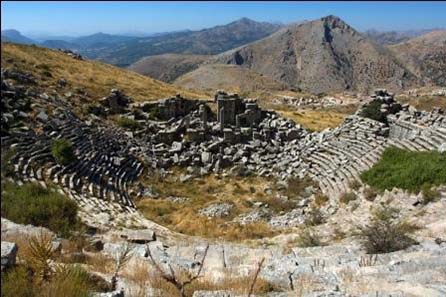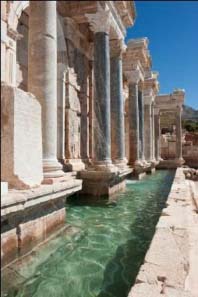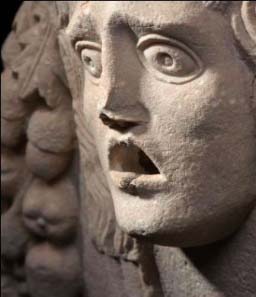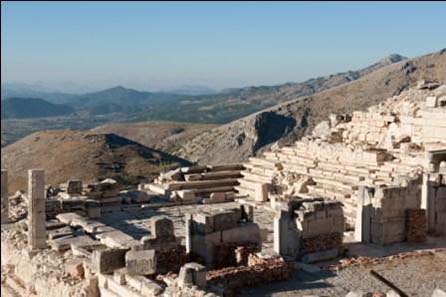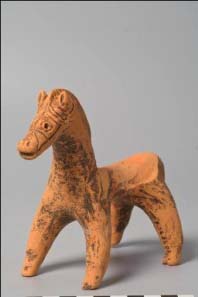October 20, 2011 – The Gallo-Romeins Museum in Tongeren, Belgium, holds an exhibition on the ancient city of Sagalassos in modern Turkey. The exhibition runs from October 29, 2011 to June 17, 2012 and shows mega-images and hundreds of objects including spectacular colossal stone heads of Hadrian and Marcus Aurelius.
Amphitheatre, built between 120 and 200 AD. © K.U. Leuven, Bruno Vandermeulen, Danny Veys.
Perched high in the mountains of southern Turkey is the monumental, ancient city of Sagalassos. Here, an ambitious Roman elite once dreamed of building a great city.
Nymphaeum on the uppermost agora, built between 160 and 180 AD. © K.U. Leuven, Bruno Vandermeulen, Danny Veys.
Temples, squares, fountains and gigantic sculptures of emperors and gods gave shape to those dreams – until the city was shaken by a devastating earthquake in the early 7th century AD. Sagalassos never recovered. The city was gradually abandoned and fell away into oblivion.
Limestone urn in the form of a vase (first century AD) © K.U. Leuven, Bruno Vandermeulen, Danny Veys.
Today, interest in Sagalassos is greater than ever. Old dreams are awakened in a temporary exhibition comprising a media installation featuring never-before-seen images of the site, 238 masterpiece artifacts leaving Turkey for the first time, and theatrical set by opera director Guy Joosten.
Bouleuterion, built shortly after 100 BC. © K.U. Leuven, Bruno Vandermeulen, Danny Veys.
For the past 22 years, Professor Marc Waelkens of K.U.Leuven has directed an international team of almost 180 scientists and excavators at Sagalassos, a site considered by many to be the ‘Pompeii of Anatolia’.
Colossal head in white marble of Roman Emperor Hadrian (120-125 AD). © K.U. Leuven, Bruno Vandermeulen, Danny Veys.
The most significant finds from the excavations at Sagalassos will be on display during the exhibition in Tongeren, including the colossal stone heads of Emperors Hadrian …
Colossal head in white marble of Roman Emperor Marcus Aurelius (161-180 AD). © K.U. Leuven, Bruno Vandermeulen, Danny Veys.
… and Marcus Aurelius, excavated in 2007 and 2008 respectively. The first head was the centerpiece of an important exhibition dedicated to Hadrian at the British Museum in 2008 and the discovery of the second head, also in 2008, was ‘breaking news’ on BBC World.
Ceramic horse miniature (ca. 400-600 AD). © K.U. Leuven, Bruno Vandermeulen, Danny Veys.
The most prepossessing of the excavated sculptures are displayed in an arresting set by opera director Guy Joosten. Almost 250 authentic objects – ranging from prehistoric tools and red-painted pottery dishes through fragments of bronze statues and oil lamps bearing Christian motifs to frieze slabs decorated with dancing nymphs and lavishly embellished capitals – illustrate the complex and fascinating history of the Roman city and surrounding area.
For details on the exhibition and the Gallo-Romeins Museum in Tongeren, please click here.
Further information on the Sagalassos excavation site in Turkey you will find on the project’s website.
The Leuven Research & Development Sagalassos Division is an interdisciplinary research group, which focuses on the archaeological site of Sagalassos in Turkey. You can visit its site here.





